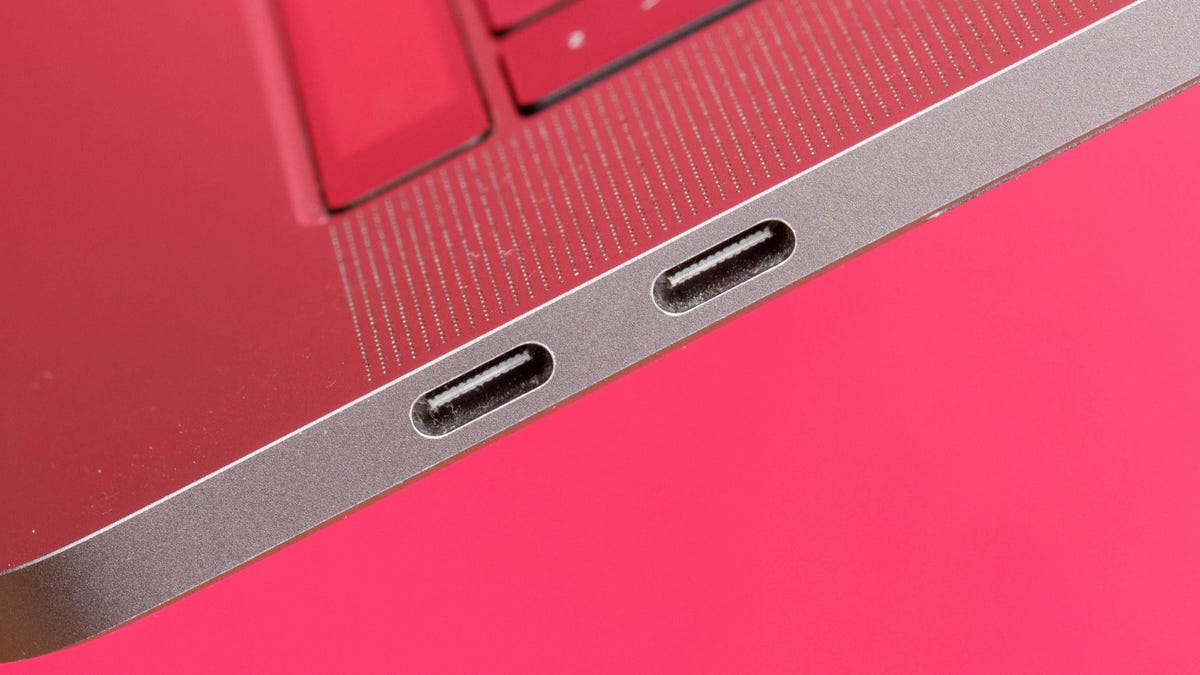 Why You Can Trust CNET
Why You Can Trust CNET Confused by USB names? Get used to it as USB 3.1 becomes 3.2
The group behind the technology is trying to simplify labels, though.

The MacBook Pro sports reversible USB-C ports.
If you're trying to decode the feature list of the latest tech product, you can probably appreciate the snarky tech saying, "There are only two hard things in computer science: cache invalidation and naming things."
You probably won't lose any sleep over cache invalidation, but names can indeed be a problem if you're buying a PC, phone, external hard drive or some other device with a USB port. That's because the trade group overseeing USB has a bunch of potentially confusing labels. Oh, and by the way, those names can change even when the underlying technology doesn't.
The newest example: What used to be called USB 3.1 is now USB 3.2. Don't panic, though -- we'll spell out the details below.
USB started more than two decades ago as a data-transfer technology, but it's expanded to charging phones and now powering laptops . But as USB's abilities grew, the labels to describe those abilities became steadily more complicated.
And that's the trouble, because if you can't understand the differences between USB 3.1, USB-C and USB PD, you might buy the wrong cable or be surprised how slow your new external hard drive is.
Read more: The best USB-C PD chargers of 2019
The trade group behind the technology, called the USB Implementers Forum or USB-IF, sensitive to recent criticism, is trying to tidy its labels and logos up some to ease confusion.
"We are exploring some improvements to target overall simplification," USB-IF Chairman Brad Saunders said Wednesday. "I expect that over the course of this year, some further improvements that we are looking at will be worked out and start to have an impact."
The Wi-Fi Alliance, which markets the wireless network technology, believes technobabble can be a problem, moving to more human-friendly terms like Wi-Fi 5 and Wi-Fi 6 instead of the specification names of IEEE 802.11ac and 802.11ax. But naming fluid technology products is never going to be simple. Look no further than Microsoft's Windows versions, which include 3.0, 3.1, 95, 98, Me, 2000, XP, 7, 8, 10 and most recently Windows 10 Fall Creators Update version 1809.
What's this about USB 3.0 and 3.1 and 3.2?
USB covers a lot of ground. One of the key parts is how fast it can transfer data. This is where the latest confusion comes from.
There are plenty of USB logos to choose from to denote things like charging and data-transfer abilities, but they don't always appear on products.
USB 3.0 arrived with the ability to transfer data at 5 gigabits per second, or 5Gbps. But when the USB-IF doubled that to 10Gbps, it renamed USB 3.0 to USB 3.1 Gen 1 and called the faster version USB 3.1 Gen 2.
Now we're getting another speed doubling and name change: USB 3.2 Gen 1 is 5Gbps, USB 3.2 Gen 2 is 10Gbps, and USB Gen 2x2 is 20Gbps. The much older USB 2.0, at 480Mbps, hasn't changed names.
Why give the old technology a new name? Because it's easier to absorb the earlier technologies into a broader USB 3.2 documentation so engineers have a single reference to check, USB-IF said.
USB-IF wants everyone to use its more human-friendly terms: USB 2.0 is USB Hi-Speed, and the version 3 variations are USB SuperSpeed 5Gbps, USB SuperSpeed 10Gbps and USB SuperSpeed 20Gbps.
"The internal details of the technical specification aren't intended to be used with consumers, nor do we intend that the specification version numbering (3.0, 3.1, etc.) be used for this purpose," Saunders said.
Fine. But as a quick glance at Amazon shows, product packages and descriptions are loaded with references to the technical specification names like USB 3.0 and 3.1.
What about USB PD, USB-C and all that?
The SuperSpeed variations govern only one part of USB: how fast it can transfer data. But you're likely to run into a lot of other USB terms.
First is the newer USB-C technology, sometimes called USB Type-C. This refers only to the physical part of USB -- the connectors at the ends of cables and the ports on the sides of your devices -- not its capacity for data or electrical power. USB-C is reversible, so there's no fiddling to get the cable right side up, and it works on laptops, tablets and phones.
USB-C doesn't guarantee a fast connection -- indeed, many of the first phones using USB-C connectors only could transfer data at the old speeds of USB 2.0, err, I mean USB Hi-Speed. But if you want the new 20Gbps speeds, USB-C connections are required.
Here's another term you'll likely encounter: USB Power Delivery, or USB PD. This technology governs USB's increasing utility providing electrical power, whether from a wall socket or a battery. It's designed to automatically figure out how much juice your device can handle -- whether that's the 100-watt maximum a high-end laptop might desire or the lower levels for phones and other smaller devices.
What's not yet clear is how USB-IF will name what's next. Because another USB speed doubling to 40Gbps is possible if not yet available. USB 3.3? USB SuperSpeed 40Gbps? USB 4.0? The USB-IF wouldn't comment on the matter. But regardless of the name, we'll always have a challenge getting up to speed.
Originally published Feb. 27, 3:15 p.m. PT
Update, Feb. 28, 10:06 a.m.: Adds further comment from USB-IF.

